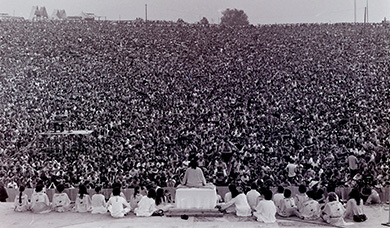| << Chapter < Page | Chapter >> Page > |

On the way to Woodstock, Glenn Weiser remembers that the crowds were so large they essentially turned it into a free concert:
As we got closer to the site [on Thursday, August 14, 1969] we heard that so many people had already arrived that the crowd had torn down the fences enclosing the festival grounds (in fact they were never put up to begin with). Everyone was being allowed in for free. . . .
Early on Friday afternoon about a dozen of us got together and spread out some blankets on the grass at a spot about a third of the way up the hill on stage right and then dropped LSD. I took Orange Sunshine, a strong, clean dose in an orange tab that was perhaps the best street acid ever. Underground chemists in southern California had made millions of doses, and the nation was flooded with it that summer. We smoked some tasty black hashish to amuse ourselves while waiting for the acid to hit, and sat back to groove along with Richie Havens.
In two hours we were all soaring, and everything was just fine. In fact, it couldn’t have been better—there I was with my beautiful hometown friends, higher than a church steeple and listening to wonderful music in the cool summer weather of the Catskills. After all, the dirty little secret of the late ‘60s was that psychedelic drugs taken in a pleasant setting could be completely exhilarating.
—Glenn Weiser, “Woodstock 1969 Remembered”
In this account, Glenn Weiser describes both the music and his drug use. What social trends did Woodstock reflect? How might the festival have influenced American culture and society, both aesthetically and behaviorally?
As the young, primarily white men and women who became hippies strove to create new identities for themselves, they borrowed liberally from other cultures, including that of Native Americans. At the same time, many Indians were themselves seeking to maintain their culture or retrieve elements that had been lost. In 1968, a group of Indian activists, including Dennis Banks, George Mitchell, and Clyde Bellecourt, convened a gathering of two hundred people in Minneapolis, Minnesota, and formed the American Indian Movement (AIM) ( [link] ). The organizers were urban dwellers frustrated by decades of poverty and discrimination. In 1970, the average life expectancy of Indians was forty-six years compared to the national average of sixty-nine. The suicide rate was twice that of the general population, and the infant mortality rate was the highest in the country. Half of all Indians lived on reservations, where unemployment reached 50 percent. Among those in cities, 20 percent lived below the poverty line.

Notification Switch
Would you like to follow the 'U.s. history' conversation and receive update notifications?